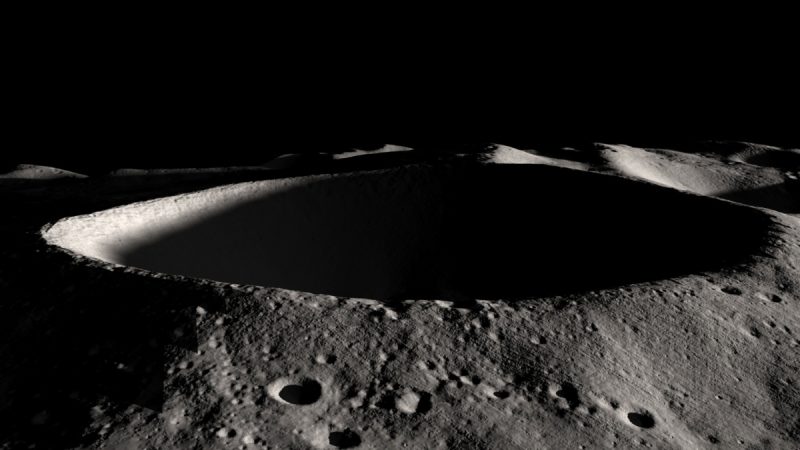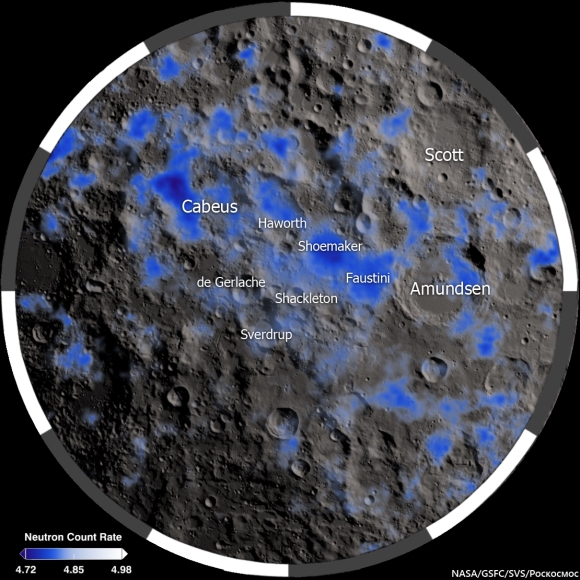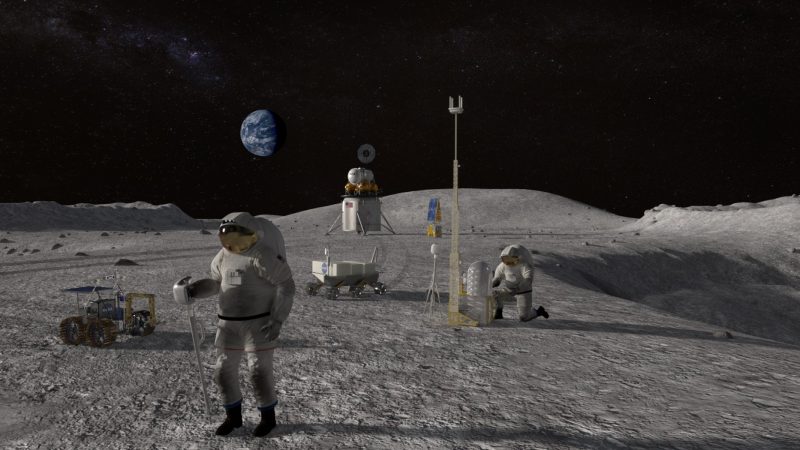

Deep and shadowed Shackleton Crater, near the moon’s south pole, is one location where deposits of water ice have been found. This ice is of interest to scientists and potentially useful to future moon explorers. Image via NASA/Goddard Space Flight Center/Leonard David’s Inside Outer Space.
We tend to think of the moon as a dusty, bone-dry place, and for the most part, that is true. But the moon does have ice, in particular at the south pole, hidden in shadowed craters. Just how the ice got there has been a bit of a mystery, but now a new study suggests it may have various sources, both ancient and more recent.
The new peer-reviewed findings were published in Icarus on September 30, 2019.
This water ice has much value, both to scientists and future human explorers. According to Ariel Deutsch, lead author of the study and a graduate student at Brown University:
The ages of these deposits can potentially tell us something about the origin of the ice, which helps us understand the sources and distribution of water in the inner solar system. For exploration purposes, we need to understand the lateral and vertical distributions of these deposits to figure out how best to access them. These distributions evolve with time, so having an idea of the age is important.
EarthSky 2020 lunar calendars are available! They make great gifts. Order now. Going fast!

Map of known water ice deposits near the lunar south pole, from NASA’s Lunar Reconnaissance Orbiter (LRO). Image via NASA/Goddard Space Flight Center/AmericaSpace.
The findings suggest that not only is some of the ice much older than the rest, but that there are probably different sources, as well. Older ice could have come from water-bearing comets and asteroids or ancient volcanism. More recent ice deposits might be the result of pea-sized micrometeorites or implantation by solar wind.
So how did the researchers come to these conclusions?
Using data from NASA’s Lunar Reconnaissance Orbiter (LRO), they looked at the ages of large craters near the moon’s south pole – such as Shackleton Crater – in which ice deposits have been found. The age of the craters can be estimated by counting the number of smaller craters inside the larger ones. Since scientists have a pretty good idea of the rate of impacts over time, they can estimate the ages of different kinds of terrain.

India’s Chandrayaan-1 spacecraft also found evidence for ice deposits on the moon back in 2009. Image via Indian Space Research Organization (ISRO)/Discover.
Most of the ice is found in very old craters, formed about 3.1 billion years ago or more. The ice can’t be any older than the craters themselves, or it would have been vaporized during the impacts. This doesn’t mean the ice must be as old as the craters, either, but it must be old since the distribution of the ice deposits on the crater floors is patchy, suggesting that it has been subjected to impacts by micrometeorites over a long period of time.
Deutsch added:
There have been models of bombardment through time showing that ice starts to concentrate with depth. So if you have a surface layer that’s old, you’d expect more underneath.
What was most surprising was ice in smaller, younger craters. This would imply that those ice deposits are also younger, and were created by a different process than the ice in the older, larger craters. As Deutsch noted:
That was a surprise. There hadn’t really been any observations of ice in younger cold traps before.
While spacecraft like LRO have confirmed the ice deposits – and others, like India’s Chandrayaan-1 mission as well – figuring out how different deposits actually formed will probably require return missions. Additional robotic missions will come first, followed, hopefully, by new crewed missions such as NASA’s planned Artemis mission. Knowing exactly where the ice deposits are located, and how much ice there is, will be important for planning future human missions back to the moon.

Future human missions to the moon, like NASA’s planned Artemis mission, will need resources such as the water ice deposits to help sustain a long-term presence. Image via NASA.
Jim Head, a professor at Brown University, explained:
When we think about sending humans back to the moon for long-term exploration, we need to know what resources are there that we can count on, and we currently don’t know. Studies like this one help us make predictions about where we need to go to answer those questions.
Ice on the moon may seem surprising, but it shouldn’t be; Mars has lots of ice, comets and some asteroids have abundant ice, there are many moons in the outer solar system completely covered in an ice crust – with oceans below! – and even Mercury has ice deposits near its north pole, in regions with permanent shadow (since there is no atmosphere to distribute heat from the sunlit areas). Scientists will now be able to compare the origins of the moon’s ice with that of other bodies in the solar system, and for future explorers, it will be a much-needed resource.
Bottom line: Water ice deposits near the moon’s south pole appear to be of different ages and have different sources, according to a new study from Brown University.
from EarthSky https://ift.tt/2VMRfvA


Deep and shadowed Shackleton Crater, near the moon’s south pole, is one location where deposits of water ice have been found. This ice is of interest to scientists and potentially useful to future moon explorers. Image via NASA/Goddard Space Flight Center/Leonard David’s Inside Outer Space.
We tend to think of the moon as a dusty, bone-dry place, and for the most part, that is true. But the moon does have ice, in particular at the south pole, hidden in shadowed craters. Just how the ice got there has been a bit of a mystery, but now a new study suggests it may have various sources, both ancient and more recent.
The new peer-reviewed findings were published in Icarus on September 30, 2019.
This water ice has much value, both to scientists and future human explorers. According to Ariel Deutsch, lead author of the study and a graduate student at Brown University:
The ages of these deposits can potentially tell us something about the origin of the ice, which helps us understand the sources and distribution of water in the inner solar system. For exploration purposes, we need to understand the lateral and vertical distributions of these deposits to figure out how best to access them. These distributions evolve with time, so having an idea of the age is important.
EarthSky 2020 lunar calendars are available! They make great gifts. Order now. Going fast!

Map of known water ice deposits near the lunar south pole, from NASA’s Lunar Reconnaissance Orbiter (LRO). Image via NASA/Goddard Space Flight Center/AmericaSpace.
The findings suggest that not only is some of the ice much older than the rest, but that there are probably different sources, as well. Older ice could have come from water-bearing comets and asteroids or ancient volcanism. More recent ice deposits might be the result of pea-sized micrometeorites or implantation by solar wind.
So how did the researchers come to these conclusions?
Using data from NASA’s Lunar Reconnaissance Orbiter (LRO), they looked at the ages of large craters near the moon’s south pole – such as Shackleton Crater – in which ice deposits have been found. The age of the craters can be estimated by counting the number of smaller craters inside the larger ones. Since scientists have a pretty good idea of the rate of impacts over time, they can estimate the ages of different kinds of terrain.

India’s Chandrayaan-1 spacecraft also found evidence for ice deposits on the moon back in 2009. Image via Indian Space Research Organization (ISRO)/Discover.
Most of the ice is found in very old craters, formed about 3.1 billion years ago or more. The ice can’t be any older than the craters themselves, or it would have been vaporized during the impacts. This doesn’t mean the ice must be as old as the craters, either, but it must be old since the distribution of the ice deposits on the crater floors is patchy, suggesting that it has been subjected to impacts by micrometeorites over a long period of time.
Deutsch added:
There have been models of bombardment through time showing that ice starts to concentrate with depth. So if you have a surface layer that’s old, you’d expect more underneath.
What was most surprising was ice in smaller, younger craters. This would imply that those ice deposits are also younger, and were created by a different process than the ice in the older, larger craters. As Deutsch noted:
That was a surprise. There hadn’t really been any observations of ice in younger cold traps before.
While spacecraft like LRO have confirmed the ice deposits – and others, like India’s Chandrayaan-1 mission as well – figuring out how different deposits actually formed will probably require return missions. Additional robotic missions will come first, followed, hopefully, by new crewed missions such as NASA’s planned Artemis mission. Knowing exactly where the ice deposits are located, and how much ice there is, will be important for planning future human missions back to the moon.

Future human missions to the moon, like NASA’s planned Artemis mission, will need resources such as the water ice deposits to help sustain a long-term presence. Image via NASA.
Jim Head, a professor at Brown University, explained:
When we think about sending humans back to the moon for long-term exploration, we need to know what resources are there that we can count on, and we currently don’t know. Studies like this one help us make predictions about where we need to go to answer those questions.
Ice on the moon may seem surprising, but it shouldn’t be; Mars has lots of ice, comets and some asteroids have abundant ice, there are many moons in the outer solar system completely covered in an ice crust – with oceans below! – and even Mercury has ice deposits near its north pole, in regions with permanent shadow (since there is no atmosphere to distribute heat from the sunlit areas). Scientists will now be able to compare the origins of the moon’s ice with that of other bodies in the solar system, and for future explorers, it will be a much-needed resource.
Bottom line: Water ice deposits near the moon’s south pole appear to be of different ages and have different sources, according to a new study from Brown University.
from EarthSky https://ift.tt/2VMRfvA

Aucun commentaire:
Enregistrer un commentaire